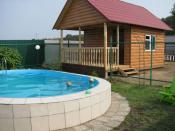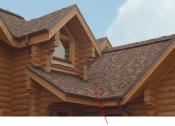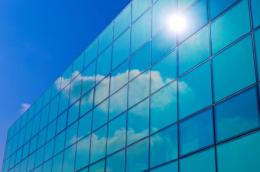Search
Login
What is self-cleaning glass, a double-glazed window which includes self-cleaning glass in combination with energy-saving. The principle of operation of self-cleaning glass
Clean and transparent glass is the neatness, beauty and comfort of any home. The cleanliness of the windows depends not only on the appearance of the housing, but also the ability to pass sunlight and heat into the room. Keeping the glass clean is a laborious and painstaking process. However, after the next rain, even the most carefully wiped windows are covered with stains.
For more comfortable operation of the windows, self-cleaning glasses are installed, which ensure the purity of translucent structures and do not require regular maintenance.
Content
- What is self-cleaning glass and its advantages
- Self-cleaning glass functionality
- Double-glazed window with self-cleaning and energy-saving glass double result
- Recommendations for use and care of self-cleaning glass video
- Scope of self-cleaning glass
What is self-cleaning glass and its advantages
The idea of \u200b\u200bcreating a special type of glass that will remain clean without regular washing appeared in the 60s of the twentieth century. Then it seemed more fantastic.
The development of technology has contributed to the appearance on the market of window structures with a self-cleaning surface. In fact, this is ordinary glass, on which a strong thin coating is applied (titanium dioxide photocatalyst), capable of self-cleaning.

A special film is applied to the street side of the glass at a very high temperature (650 degrees Celsius), which ensures their integrity.
Externally self-cleaning glass is not much different from ordinary. However, if you look closely, you can see that:
- glare on ordinary glass is not so noticeable than on self-cleaning glass (light reflection coefficient of ordinary glass is 8%, cleaning - 14%);
- coated glass has a subtle bluish tint.

Advantages of self-cleaning glass:
- The need for washing is significantly reduced, which saves time, money and effort.
- Glass self-sufficiency (due to cost savings on window cleaning).
- Decorative glass.
- Long service life of glass (the applied coating is durable, not erasable).
- Glass is capable of self-cleaning at any time of the year (cloudy and clear days).
- It is very easy to clean if necessary.
- It can be combined in double-glazed windows with other types of glasses (energy-saving, sun-protection, soundproofing).
- It is used in various options for external glazing.
Self-cleaning glass functionality
The principle of operation of self-cleaning glass
The self-cleaning process can be divided into two stages:
- The glass coating reacts violently with the sun. As a result, the effect of ultraviolet radiation on dirt is activated, that is, the natural process of decomposition of materials (oxidation) is launched and organic compounds are destroyed. In this case, the coating is a catalyst for a chemical reaction (decomposition of dirt into components). It should be noted that the catalyst (titanium dioxide) is not consumed and regenerates its chemical composition after each interaction.
- The second stage consists in washing off the residues of decomposition of dirt, inorganic compounds by rain or water. Due to the hydrophilic properties of the coating, water is distributed over the surface with a wide even layer, wetting the accumulated dirt residues. The resulting film slides off the glass, evenly washing away the dirt. Even if the water is hard with a high salt content, all the same, there will be no drips on the window.

Glass begins to work in five to seven days after the installation of the window structure. This time is enough to activate the hydrophilicity of the surface (under the influence of UV rays) and the glass starts to work constantly, including at night or in cloudy weather.
To increase the efficiency of self-cleaning glass, it is not recommended to wash it yourself before the first rain
Pollution handled by self-cleaning glass
The principle of self-cleaning glass acts primarily on organic pollution. These include products of animal and plant origin: tree sap, fingerprints, bird droppings and plant pollen.

Dirty glass will clear within an hour if the layer of accumulated organic compounds is 6 nm
A chemical reaction occurs continuously, so even severe pollution disappears over time.
Nano-coating allows you to wash off and barely noticeable oily film from incomplete fuel combustion.
Inorganic contaminants that decay under the influence of UV rays can be attributed to: various types of dust (cement, road, chalk) and salt streaks that appeared after using hard water.
Situations that require additional glass washing

This is not to say that a window with a self-cleaning glass will not have to be washed at all. Consider the possible cases when you have to take care of the glass yourself:
- if the layer of dirt has increased so much that through it the ultraviolet rays do not interact with the surface of the window, the glass simply ceases to function normally;
- during a prolonged drought (the time for which the glass ceases to fulfill its functions, lacking water depends on the location of the window structure: close to the motorway, industrial area or suburban household plot);
- glass cannot clean itself of paints and varnishes and many inorganic compounds.
Double-glazed window with self-cleaning and energy-saving glass double result
Windows with self-cleaning glass can also perform additional functions (sun protection, energy saving, sound insulation, safety, and others). These characteristics can be achieved by combining various types of glasses.
One of the most effective and convenient solutions is a double-glazed window with self-cleaning and energy-saving glass.

The inner glass of the window construction is energy-saving (low emission glass). A layer (or several layers) of metals, usually silver, is applied to the surface of the glass. This layer reduces the emissivity of the glass (from 0.83 to 0.04), which allows you to retain heat in the room.

Energy-saving glass can be of two types: hard and soft. Solid glass is sprayed with an alloy of tin and indium. It increases the thermal insulation properties of the window by 6-8 times.
Soft glass is coated with various metals, including silver, and is able to retain heat indoors ten times more than ordinary glass.
A glass with a self-cleaning coating is installed on the outside of the window. Such a window construction is not cheap, but after a couple of seasons of operation, it will pay for itself. Double-glazed windows can significantly save on the costs of heating the premises and washing window structures.
Recommendations for use and care of self-cleaning glass

During unloading and storage of glass with a self-cleaning coating, it is necessary to adhere to some rules:
- during transportation, the glass should be in a protective film;
- loading and unloading of glass is carried out in clean cotton gloves;
- the processed glass surface can be determined by a special hologram (in the corner of the glass) or by using a special hand sensor;
- suction cups must not slip on the coated surface;
- stickers, markings, inscriptions with wax pencils on glass are not allowed, since during their removal self-cleaning coating can be damaged.
Washing glass with a self-cleaning surface is easier than cleaning ordinary glass. To remove dirt, it is necessary to wash the window from the hose, this will be enough to resume its functionality. It is not necessary to polish the window surface, since water, when dried, will not leave streaks or sag.

If the window is very dirty, you can wipe it with a sponge or a soft cloth dampened in soapy water. After which, rinse the window surface with plenty of water.
When caring for a window with a self-cleaning surface, it is important to ensure that abrasive materials and metal objects (when using washing equipment) do not come in contact with glass. You can use alcohol and ammonia-based cleaners.
Scope of self-cleaning glass
Glass with an active surface can be used where there is access to sunlight and water, that is, almost everywhere. They are installed on building facades, greenhouses, skylights and roofs. Glass can be bent, located in any position (vertically, horizontally). The use of self-cleaning glass indoors is excluded.

New technologies are beginning to be applied in car windows. Already today, models with self-cleaning glasses, without wipers, have been released.

The invention of an innovative coating that provides clear and clean glass can be called a brilliant discovery, which greatly facilitates the operation of window structures.





